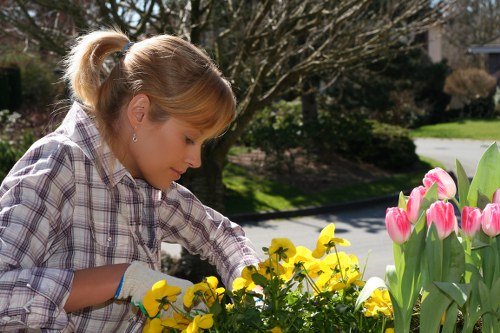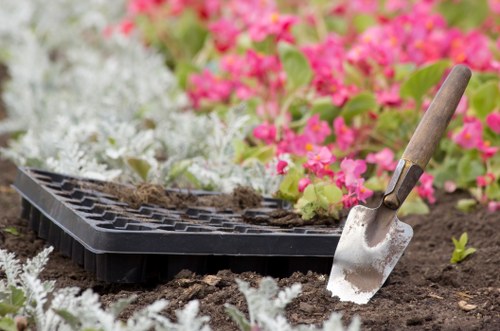Comprehensive Guide to Garden Fence Replacement in Lawn Mower

Maintaining a beautiful garden often involves various elements, and one crucial aspect is ensuring that the garden fence is in excellent condition. A sturdy fence not only enhances the aesthetic appeal of your garden but also provides security and defines boundaries. However, over time, garden fences can deteriorate due to weather conditions, wear and tear, or other factors, necessitating replacement. This guide will delve into the intricacies of garden fence replacement, offering valuable insights to help you make informed decisions.
When considering a garden fence replacement, it's essential to evaluate the current state of your fence. Look for signs of damage such as rotting wood, rusted metal, or broken panels. These indicators will help you determine whether a simple repair will suffice or if a complete replacement is necessary. Additionally, assessing your garden's layout and your specific needs will guide you in selecting the most suitable fence type.
The process of replacing a garden fence involves several steps, from choosing the right materials to the actual installation. Understanding each phase will ensure a smooth and efficient replacement process. Let's explore the key factors to consider when embarking on a garden fence replacement project.

Assessing the Need for Fence Replacement
Before proceeding with a garden fence replacement, it's crucial to assess the need thoroughly. Start by inspecting your existing fence for structural integrity. Look for loose boards, missing nails, or signs of insect damage. If the damage is extensive, replacement might be more cost-effective than repairs.
Consider the functionality of your fence as well. If your current fence no longer serves its intended purpose, such as keeping pets or children safe, or if it's not providing adequate privacy, it might be time to replace it. Additionally, outdated fence designs may not complement your garden's current aesthetic, making a replacement a viable option.
Understanding the reasons behind the replacement will help you set clear objectives for your project. Whether it's for improved durability, enhanced appearance, or better functionality, defining your goals is the first step toward a successful fence replacement.

Choosing the Right Materials
One of the most critical decisions in a fence replacement project is selecting the appropriate materials. The choice of material will impact the fence's durability, maintenance requirements, and overall appearance. Here are some common materials used for garden fences:
- Wood: A classic choice, wood offers a natural look and can be customized through staining or painting.
- Vinyl: Known for its low maintenance, vinyl fences are resistant to weather and pests.
- Metal: Options like aluminum or wrought iron provide strength and an elegant appearance.
- Composite: Combining wood fibers and plastic, composite fences are durable and eco-friendly.

Design and Style Considerations
The design and style of your new garden fence should align with your garden's overall aesthetic and your personal preferences. Consider the following aspects when selecting a fence design:
- Height: The fence height determines the level of privacy and security it provides. Taller fences offer more privacy but may require permits in some areas.
- Color: Choose a color that complements your garden's color palette. Natural wood tones, white, and earthy shades are popular choices.
- Style: From traditional picket fences to modern horizontal slats, select a style that matches your garden's character.
- Gate Design: Incorporate gates that are functional and aesthetically pleasing, ensuring easy access to your garden.

Installation Process
Preparing the Area
Proper preparation is essential for a successful fence replacement. Start by removing the old fence carefully, ensuring that you don't damage the existing landscape. Clear the area of any debris and level the ground to provide a stable foundation for the new fence.
Measuring and Planning
Accurate measurements are critical to ensure that your new fence fits perfectly within the designated area. Measure the length and height of the fence line, and mark the locations for the fence posts. Planning the layout in advance will help streamline the installation process.
Installing Fence Posts
Fence posts provide the structural support for your fence. Dig holes at the marked locations, ensuring they are deep enough to prevent the posts from shifting. Use concrete to secure the posts in place, allowing sufficient time for it to set.
Attaching Fence Panels
Once the posts are secure, attach the fence panels according to the manufacturer's instructions. Ensure that the panels are level and properly aligned to maintain a uniform appearance. Secure the panels firmly to withstand various weather conditions.
Finishing Touches
After the fence panels are in place, add any finishing touches such as staining, painting, or installing decorative elements. These final steps enhance the fence's appearance and protect it from environmental factors.

Maintenance Tips for Longevity
Maintaining your new garden fence ensures its longevity and sustained appearance. Here are some maintenance tips to keep your fence in top condition:
- Regular Cleaning: Remove dirt, moss, and debris regularly to prevent deterioration.
- Inspection: Periodically check for signs of damage or wear and address issues promptly.
- Protective Coating: Apply sealants or stains to protect the fence from moisture and UV damage.
- Vegetation Control: Keep plants and vines away from the fence to prevent growth-related damage.

Cost Considerations
Replacing a garden fence involves various costs, including materials, labor, and any additional features you might choose. To manage expenses effectively, consider the following:
- Material Selection: Different materials come with varying price points. Choose a material that fits your budget while meeting your quality and aesthetic requirements.
- DIY vs. Professional Installation: While DIY installation can save money, hiring professionals ensures quality workmanship and saves time.
- Permits and Regulations: Check local regulations to determine if you need permits for fence replacement, which can add to the overall cost.

Environmental Impact
Considering the environmental impact of your fence materials is increasingly important. Opting for sustainable and eco-friendly materials can reduce your garden's ecological footprint. Here are some eco-conscious options:
- Reclaimed Wood: Using reclaimed or recycled wood reduces demand for new lumber and minimizes waste.
- Bamboo: A fast-growing renewable resource, bamboo fences are both sustainable and durable.
- Composite Materials: Made from recycled plastics and wood fibers, composite fences offer durability without the environmental drawbacks of traditional materials.

Enhancing Garden Aesthetics with Fence Replacement
A well-chosen fence can significantly enhance your garden's aesthetics. Here are some ways to use fence replacement to elevate your garden's look:
- Color Coordination: Match the fence color with your garden furniture or house exterior for a cohesive look.
- Decorative Elements: Incorporate decorative features such as finials, lattice panels, or ornamental posts to add character.
- Lighting: Install solar-powered lights along the fence to create a charming nighttime ambiance.
- Green Fences: Use living fences with climbing plants or hedges to add greenery and a natural touch.

Common Mistakes to Avoid
Avoiding common mistakes during fence replacement can save you time and resources. Here are some pitfalls to watch out for:
- Poor Planning: Failing to plan the fence layout and design can lead to misalignment and aesthetic issues.
- Ignoring Local Regulations: Overlooking local building codes and regulations can result in legal complications.
- Subpar Materials: Choosing low-quality materials may lead to frequent repairs and reduced fence lifespan.
- Insufficient Post Anchoring: Poorly anchored posts can cause the fence to become unstable and unsafe.

Innovative Fence Replacement Ideas
Embrace creativity when replacing your garden fence to make it a standout feature. Here are some innovative ideas:
- Vertical Gardens: Integrate planters or vertical gardens into the fence design to add greenery and vibrant colors.
- Repurposed Materials: Use recycled materials like old windows or doors as decorative fence panels.
- Mixed Materials: Combine different materials such as wood and metal for a modern, eclectic look.
- Artistic Designs: Incorporate artistic motifs or carvings to personalize your fence.

Professional vs. DIY Fence Replacement
Deciding between professional installation and a DIY approach depends on various factors, including budget, skill level, and time availability. Here are the pros and cons of each option:
Professional Installation
- Expertise: Professionals have the necessary skills and experience to ensure a high-quality installation.
- Time-Saving: Hiring experts can significantly reduce the time required to complete the project.
- Warranty: Many professional services offer warranties, providing peace of mind.
- Higher Cost: Professional services typically come at a higher cost compared to DIY.
DIY Installation
- Cost-Effective: DIY projects can save money on labor costs.
- Personal Satisfaction: Completing the project yourself can be rewarding and fulfilling.
- Flexibility: DIY allows for more flexibility in design and scheduling.
- Skill Requirement: Successful DIY installation requires a certain level of skill and knowledge.

Tools and Equipment Needed
Having the right tools and equipment is essential for a smooth garden fence replacement. Here's a list of commonly needed items:
- Measuring Tape: For accurate measurements of the fence area.
- Post Hole Digger: To dig holes for fence posts.
- Level: Ensures that fence panels are straight and even.
- Saw: For cutting wood or other materials to size.
- Pliers and Screwdrivers: Essential for assembling fence panels.
- Cement: Used to secure fence posts in place.

Regulatory Considerations
Before embarking on a garden fence replacement, it's important to understand and comply with local regulations. Here are some key considerations:
- Permits: Some areas require permits for fence installation, especially if the fence exceeds a certain height.
- Zoning Laws: Be aware of zoning laws that dictate fence placement, height, and materials.
- Property Boundaries: Clearly define your property boundaries to avoid encroaching on your neighbor's land, which could lead to disputes.
- Homeowners Association (HOA) Rules: If you live in an area governed by an HOA, ensure that your fence complies with their guidelines.

Sustainable Fence Replacement Practices
Incorporating sustainability into your fence replacement project benefits both the environment and your garden. Here are some sustainable practices to consider:
- Use Eco-Friendly Materials: Opt for materials that are recyclable, renewable, or have a low environmental impact.
- Minimize Waste: Plan your project carefully to reduce material waste. Reuse or recycle old fence materials when possible.
- Energy-Efficient Finishes: Choose stains and paints that are low in volatile organic compounds (VOCs) to reduce environmental pollution.
- Install Solar Lighting: Incorporate solar-powered lights into your fence design to enhance functionality while conserving energy.

Benefits of Timely Fence Replacement
Replacing your garden fence in a timely manner offers numerous benefits:
- Enhanced Security: A new fence provides better security against intruders and protects your garden from unwanted animals.
- Increased Property Value: A well-maintained fence can boost your property's curb appeal and overall value.
- Improved Aesthetics: A fresh, new fence enhances the visual appeal of your garden and complements your landscape design.
- Reduced Maintenance Costs: Investing in a durable fence reduces the need for frequent repairs and maintenance.

Case Studies: Successful Fence Replacements
Examining successful fence replacement projects can provide inspiration and practical insights. Here are a couple of case studies:
Case Study 1: Wooden Fence Transformation
A homeowner with a deteriorating wooden fence opted for a complete replacement using cedar wood. The new fence not only restored the garden's beauty but also provided enhanced privacy and durability. The installation process was smooth, and the homeowner appreciated the low maintenance required for cedar wood.
Case Study 2: Modern Vinyl Fence Installation
Another homeowner chose a modern vinyl fence to replace an old, rusty metal fence. The vinyl fence was easy to install, resistant to weather conditions, and required minimal upkeep. The sleek design complemented the contemporary look of the garden, making it a perfect choice for the homeowner's preferences.

Frequently Asked Questions (FAQs)
1. How long does a garden fence typically last?
The lifespan of a garden fence depends on the material used. Wooden fences can last 15-30 years with proper maintenance, while vinyl and metal fences can last 20-40 years or more.
2. Can I replace my garden fence without professional help?
Yes, if you have the necessary tools and skills, DIY fence replacement is possible. However, for larger projects or if you're unsure, hiring professionals is recommended.
3. What permits are required for fence replacement?
Permit requirements vary by location. It's essential to check with your local municipality or homeowners association to determine if permits are needed for your fence replacement project.
4. How do I maintain my new garden fence?
Regular cleaning, inspections, and applying protective coatings are key to maintaining your fence. Address any damages promptly to prevent further deterioration.
5. What is the most durable fence material?
Materials like vinyl, metal, and composite are known for their durability. The choice depends on your specific needs, aesthetic preferences, and budget.

Conclusion
Replacing your garden fence is a significant project that can greatly enhance your garden's functionality and beauty. By carefully assessing your needs, choosing the right materials, and following best practices for installation and maintenance, you can ensure a successful fence replacement. Whether you opt for a classic wooden fence, a low-maintenance vinyl option, or an elegant metal design, a new fence will provide lasting benefits for your garden and property.
Ready to transform your garden with a new fence? Contact us today to discuss your fence replacement needs and schedule your service!